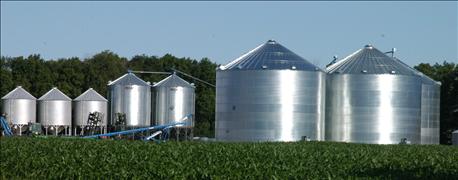June 13, 2016

Keep stored grain as cool as possible over the summer, advises Ken Hellevang, North Dakota State University Extension grain storage management specialist.
If you do it right, you can store grain for several years.
A key number is to keep in mind is 60 degrees F.
“The optimum grain temperature for insect activity is 70-90 degrees F. Reducing grain temperatures below 70 degrees F will lessen insect reproduction and activity, and lowering grain temperatures below 60 degrees F will greatly reduce insect activity,” Hellevang says.
To prevent grain temperatures from rising above 60 degrees F,

Grain bins catch the sunlight on a summer morning. Solar energy will heat up grain stored inside unless the bins are ventilated.
1) Cover aeration fans to prevent wind and a natural chimney effect from warming the grain. Wind blowing into uncovered fans or ducts will move air through the grain in a way that is similar to operating an aeration fan.
2) Ventilate the space between the grain and the bin roof can reduce the amount that the grain near the top of the bin is warmed. Natural ventilation to cool this space can occur if the bin has openings near the eave and peak; these openings work like the vents in an attic of a building. The heated air rises and exits near the peak, drawing in cooler air near the eave. This natural ventilation will not occur unless the bin has adequate openings at the eave and peak. Roof exhaust fans controlled by a thermostat also can be used to draw the heated air out of the bin if openings are available to allow air into the area above the grain.
3) Cool grain in the upper portion of the bin by operating the aeration fan about every three weeks during a cool early morning. Using positive-pressure aeration to push air up through the grain enables the cool grain in the bottom of the bin to cool the air, which then cools the grain near the top of the bin. Run the fan only long enough to cool the grain near the top surface. That may require running the fan for a few hours during a cool, dry morning for a couple of days. Running the fan more than necessary will warm more grain at the bottom of the bin, increasing the potential for storage problems.
“If the air dew point is warmer than the grain temperature or if the air relative humidity is high, some moisture will condense onto the grain during fan operation. Condensing moisture will release heat that will warm the air slightly, reducing the effectiveness of the aeration and increasing the amount of warming occurring in the grain at the bottom of the bin. Therefore, selecting mornings when the air is cool and dry is important,” Hellevang says.
4) Measure and record the stored grain temperature at several locations near the top surface, along the walls and within the stored grain. Temperature sensors are an excellent tool when monitoring stored grain, but remember that they only measure the temperature of the grain next to the sensor. Because grain is a good insulator, the grain temperature may be much different just a few feet from the sensor. Increasing grain temperature may be an indicator of an insect infestation or mold growth.
5) Verify that the grain moisture content is dry enough for storage at summer temperatures. The recommended long-term grain storage moisture contents are about 13.5% for wheat, 12% for barley, 13.5% for corn, 11% for soybeans, 13% for grain sorghum, 8% for oil sunflowers and 10% for confectionary sunflowers. The market moisture content may be higher, but storing warm grain at higher moisture contents may lead to mold growth on the grain.
6) Check bins every two weeks. Mold growth and insect infestations occur rapidly at summer temperatures. “A situation with only a few insects can turn into a major infestation in less than a month,” Hellevang says. Tip: Using insect traps or placing grain samples on white material helps you look for insects.
NDSU Extension provided information for this article.
You May Also Like




